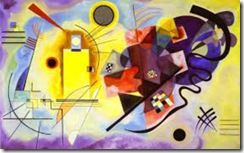Study of three artists
Artist one – Herta Puls
Examples of Mola embroidery
Herta Puls studied the Mola embroidery of the Kuna Indians in the Sans Blas Islands. The word Mola, is “Morra” in Kuna language and means the outfit of the female Kuna and it has a deep relationship with nature.
The Mola embroidery pieces are relevant to this Module as they are made using the reverse appliqué technique that we studied.
Kuna reverse appliqués are created using intricate patterns on several layers of fabric which are cut out of the top layers to reveal the more colourful layers underneath. The edges are turned and stitched and the edges of the patterns may have multiple coloured edges. The colours come from the principal colours: the red, black and orange. During the module we tried reverse applique where we turned and stitched the edges to create clear definition as in the Mola embroidery. We also made samples where we left the edges raw to create less defined edges.
The following website http://www.molaartandcraft.com/links.php?27219#.VQAkAU1yZdc shows the stages of creating Mola embroidery.
Artist two – Kandinsky
Examples of Kandinsky’s use of overlapping shapes in composition.
‘Composition 8’ ‘Yellow, red, blue’
Kandinsky was a Russian artist who is regarded as one of the great masters of modern art and in particular of abstract painting. He invented a language of abstract forms with which he replaced the forms of nature. He felt that painting possessed the same power as music and that sign, line, and colour ought to correspond to the vibrations of the human soul.
In terms of relevance to this module, I think that Kandinsky’s use of composition and shape is relevant. His skill of composition is very inspiring. During the module we had to create asymmetric designs by folding and cutting shapes and then placing them on top of each other. I found this element quite uncomfortable as the shapes didn’t appear balanced. I can see from Kandinsky’s art, that there is a real skill in producing something that appears abstract, but which has balance and enables all the elements to work together.
I also note that Kandinsky frequently used cross shapes, which are relevant to this Module too. For example, the illustration below shows a part of the top left corner of Composition 8 which has similarities to the Russian Orthadox cross, which I drew as part of my early research on the module. In many cases crosses were formed by the overlapping of lines and shapes in his compositions.
Artist three – Antoni Gaudi
My choice of artist is Antoni Gaudi, the Spanish architect. I first became aware of Gaudi’s work during a trip to Barcelona about 20 years ago. I remember being stunned at the sheer beauty and extravagance of his work and feeling grateful that someone had created such amazing buildings that we can all enjoy.
Background
Gaudi was born in Reus in Spain in 1852 and died in Barcelona in 1926.
Gaudi’s work is described as Catalan Modernism and has a highly individual style. The vast majority of his works are situated in the Catalan capital of Barcelona, including his magnum opus, the Sagrada Família which is one of the most visited monuments in Spain. Much of Gaudi’s work was marked by the four passions of his life: architecture, nature, religion and his love for Catalonia.
Gaudi integrated into his architecture a series of crafts, in which he himself was skilled, such as ceramics, stained glass, wrought ironwork forging and carpentry. He also introduced new techniques in the treatment of the materials, such as his famous trencadis (mosaic) made of waste ceramic pieces.
Gaudi’s work transcended mainstream Modernism; it had an organic style. Between 1984 and 2005 seven of his works were declared World Heritage Sites by UNESCO.
The Sagrada Familia
In his later year’s Gaudi became uninterested in his appearance, having dedicated himself completely to his work and to his religion. On 7 June 1926, Gaudi was walking towards the church where he went daily to pray and confess. He was knocked down by a tram. Assumed to be a beggar because of his lack of identity documents and neglected appearance, it was a while until anybody came to his aid. Finally, a policeman stopped a taxi and took him to the hospital. The next day, the chaplain of the Sagrada Familia, recognized him but it was too late. Gaudi died on 10 June 1926, at the age of 73, at the height of his career.
Relevance to this module
It was only when I was looking through some of my text books whilst researching artists for this module that I realised the relevance of Gaudi’s work to this module i.e. the cross shape and the colours.
Gaudi was a devout man and crosses can be seen in many of his works; a fact which has led to his being nicknamed “God’s Architect” and calls for him to be beatified. A frequent motif of Gaudi’s work was the four-armed cross – see images below.
 |
 |
 |
 |
Gaudí created this cross to symbolize the way the Gospel is ever expanding, spreading out to the “four corners” of the globe.
Gaudi’s use of colour is also relevant to this module as he often used the blue and gold/orange/yellow colours that I chose to use for this module.
An architect may seem an unlikely choice as inspiration for textile art. One may tend to think of the hard architectural materials, i.e. bricks, concrete, steel, and the functionality of many buildings which do not always display much beauty. This could not be further from the truth for Gaudi. The jewel-like colours, intricate decorative patterns, variety of materials and decorative techniques, and the organic design of his buildings provide a very rich source of inspiration for any artist.












